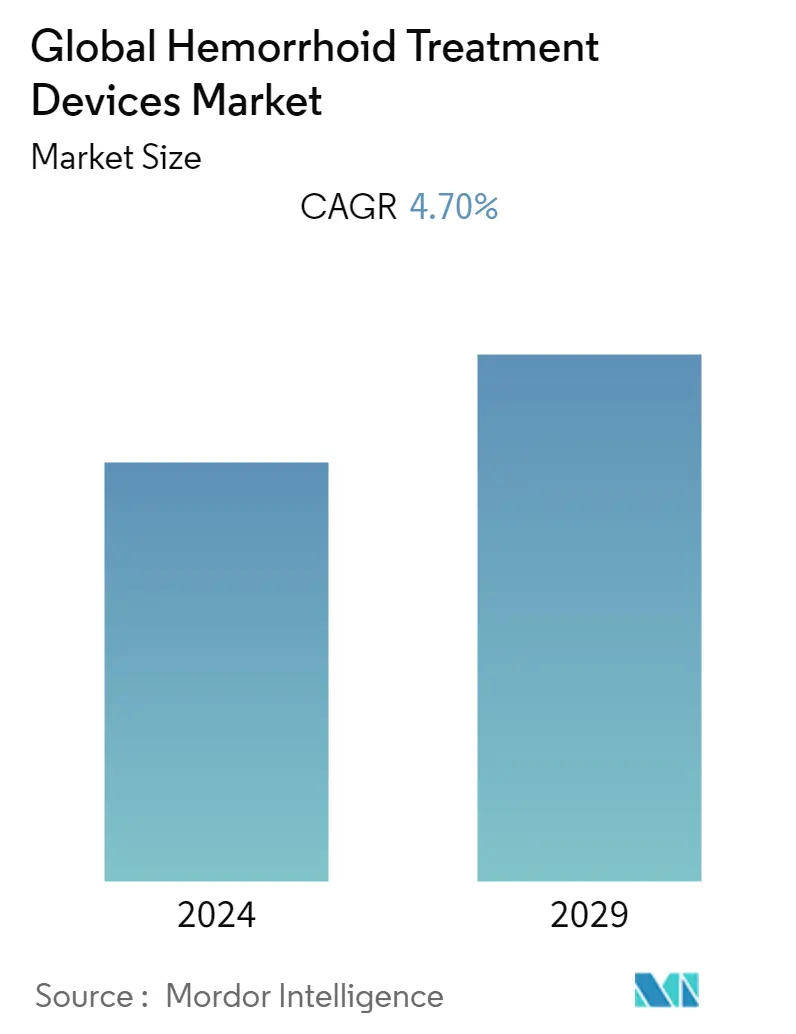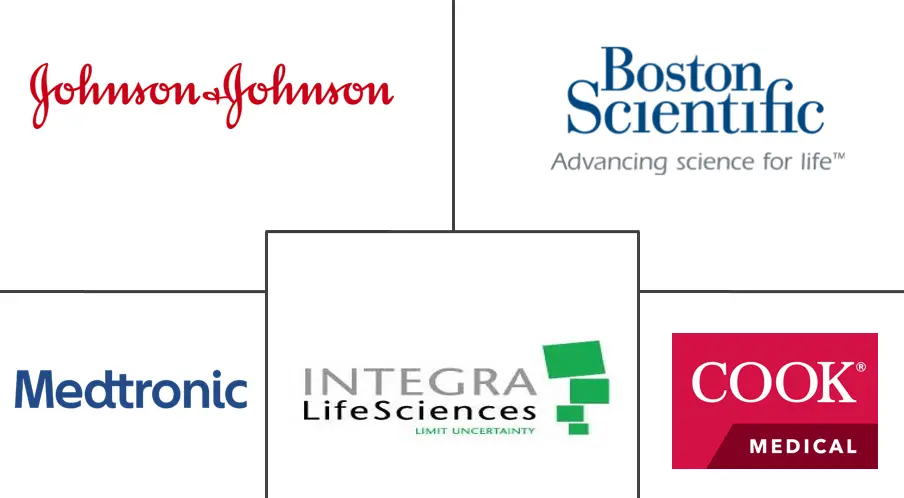Market Size of Global Hemorrhoid Treatment Devices Industry

| Study Period | 2019 - 2029 |
| Base Year For Estimation | 2023 |
| CAGR | 4.70 % |
| Fastest Growing Market | Asia Pacific |
| Largest Market | North America |
| Market Concentration | Medium |
Major Players
*Disclaimer: Major Players sorted in no particular order |
Hemorrhoids Treatment Market Analysis
The hemorrhoid treatment devices market is expected to register a CAGR of 4.7% during the forecast period (2022-2027).
The COVID-19 pandemic was an unprecedented health concern and adversely affected communities, industries, businesses, and lives worldwide. The rising COVID-19 cases across the globe have had a profound impact on the market. For instance, a research study titled "Impact of COVID-19 Quarantine on Advanced Hemorrhoidal Disease and the Role of Telemedicine in Patient Management", published in October 2020, stated that COVID-19-related delays are linked to a deterioration of hemorrhoidal symptoms and patients' well-being. Weight loss and lifestyle changes were deemed critical factors in determining disease severity. Thus, COVID-19 had a pronounced impact on the growth of the market.
A hemorrhoid is an abnormal mass of engorged and dilated blood vessels in swollen tissue that occurs internally in the anal canal or externally around the anus that may be characterized by bleeding, pain, or itching. Hemorrhoids can develop inside the rectum (internal hemorrhoids) or under the skin around the anus (external hemorrhoids). Some effective treatment options, such as band ligators and bipolar probes, are available for hemorrhoids, but most people get relief with home treatments and lifestyle changes.
Moreover, the growing number of research studies is one of the major factors driving the growth of the market. For instance, a research study titled "Prevalence and associated factors of hemorrhoids among adult patients visiting the surgical outpatient department in the University of Gondar Comprehensive Specialized Hospital, Northwest Ethiopia" published in April 2021 stated that the overall prevalence of hemorrhoids was high, and its prevalence was higher in male subjects. Constipation and being overweight were found to increase the odds of having hemorrhoids. Screening for early identification and intervention of hemorrhoids, especially for high-risk groups, is better practiced by health professionals. Hence, the increasing diagnosis will lead to an increase in demand for treatment and thus drive market growth in the future.
The increasing number of clinical trials is also expected to propel the growth of the market. For instance, the clinical study titled "Comparative Study on Endoscopic Treatments for Hemorrhoids (METHOD): a Multicenter, Randomized Controlled Clinical Trial" was started in May 2022 and is expected to be completed by January 2025, sponsored by Fangyu Wang. Such studies to find out the effectiveness of the different devices may lead to the usage of new devices in the treatment of hemorrhoids in the future and thus are expected to impel the growth of the market.
Thus, owing to the abovementioned factors, the market is expected to project growth over the forecast period. However, the availability of several drugs as alternate treatment options will hinder market growth in the future.
Hemorrhoids Treatment Industry Segmentation
As per the scope of the report, a hemorrhoid is an abnormal mass of engorged and dilated blood vessels in swollen tissue that occurs internally in the anal canal or externally around the anus, characterized by bleeding, pain, or itching. Hemorrhoid Treatment Devices Market is segmented By Product Type (Band Ligators, Bipolar Probes, Laser Probes, Cryotherapy Devices, Infrared Coagulators, Sclerotherapy Injectors, and Others) and Geography (North America, Europe, Asia-Pacific, Middle-East and Africa, and South America). The market report also covers the estimated market sizes and trends for 17 countries across major global regions. The report offers the value (USD million) for the above segments.
| By Product Type | |
| Band Ligators | |
| Bipolar Probes | |
| Laser Probes | |
| Cryotherapy Devices | |
| Infrared Coagulators | |
| Sclerotherapy Injectors | |
| Others |
| Geography | ||||||||
| ||||||||
| ||||||||
| ||||||||
| ||||||||
|
Global Hemorrhoid Treatment Devices Market Size Summary
The hemorrhoid treatment devices market is poised for growth, driven by increasing awareness and advancements in treatment options. The market is characterized by a variety of devices, including band ligators and bipolar probes, which offer effective solutions for managing hemorrhoids. Despite the availability of home treatments and lifestyle changes, the demand for these devices is bolstered by ongoing research and clinical trials that explore their efficacy and safety. The COVID-19 pandemic has had a significant impact on the market, highlighting the importance of timely intervention and the role of telemedicine in managing hemorrhoidal conditions. The market's expansion is further supported by the rising prevalence of hemorrhoids, particularly in high-risk groups, which underscores the need for effective screening and treatment solutions.
North America is expected to maintain a significant share of the hemorrhoid treatment devices market, attributed to its advanced healthcare infrastructure, favorable reimbursement policies, and rapid adoption of novel products. The region's market growth is also fueled by the frequent use of band ligation methods and the introduction of new devices, such as the In-Sight Multi-Band Ligator. The presence of major players like Boston Scientific Corporation and Medtronic Plc, along with ongoing clinical trials and product launches, contributes to the competitive landscape of the market. These factors, combined with technological advancements, are anticipated to drive the market's growth trajectory over the forecast period.
Global Hemorrhoid Treatment Devices Market Size - Table of Contents
-
1. MARKET DYNAMICS
-
1.1 Market Overview
-
1.2 Market Drivers
-
1.2.1 Rise in Prevalence of Hemorrhoids
-
1.2.2 Technological Advancements in Hemorrhoid Treatment Devices
-
-
1.3 Market Restraints
-
1.3.1 Availability of Several Drugs as an Alternate Treatment Option
-
-
1.4 Porter's Five Force Analysis
-
1.4.1 Threat of New Entrants
-
1.4.2 Bargaining Power of Buyers/Consumers
-
1.4.3 Bargaining Power of Suppliers
-
1.4.4 Threat of Substitute Products
-
1.4.5 Intensity of Competitive Rivalry
-
-
-
2. MARKET SEGMENTATION (Market Size by Value - USD million)
-
2.1 By Product Type
-
2.1.1 Band Ligators
-
2.1.2 Bipolar Probes
-
2.1.3 Laser Probes
-
2.1.4 Cryotherapy Devices
-
2.1.5 Infrared Coagulators
-
2.1.6 Sclerotherapy Injectors
-
2.1.7 Others
-
-
2.2 Geography
-
2.2.1 North America
-
2.2.1.1 United States
-
2.2.1.2 Canada
-
2.2.1.3 Mexico
-
-
2.2.2 Europe
-
2.2.2.1 Germany
-
2.2.2.2 United Kingdom
-
2.2.2.3 France
-
2.2.2.4 Italy
-
2.2.2.5 Spain
-
2.2.2.6 Rest of Europe
-
-
2.2.3 Asia-Pacific
-
2.2.3.1 China
-
2.2.3.2 Japan
-
2.2.3.3 India
-
2.2.3.4 Australia
-
2.2.3.5 South Korea
-
2.2.3.6 Rest of Asia-Pacific
-
-
2.2.4 Middle-East and Africa
-
2.2.4.1 GCC
-
2.2.4.2 South Africa
-
2.2.4.3 Rest of Middle-East and Africa
-
-
2.2.5 South America
-
2.2.5.1 Brazil
-
2.2.5.2 Argentina
-
2.2.5.3 Rest of South America
-
-
-
Global Hemorrhoid Treatment Devices Market Size FAQs
What is the current Global Hemorrhoid Treatment Devices Market size?
The Global Hemorrhoid Treatment Devices Market is projected to register a CAGR of 4.70% during the forecast period (2024-2029)
Who are the key players in Global Hemorrhoid Treatment Devices Market?
Boston Scientific Corporation, Medtronic Plc, Cook Medical, DePuy Synthes (Johnson & Johnson) and Integra LifeSciences Corporation are the major companies operating in the Global Hemorrhoid Treatment Devices Market.

